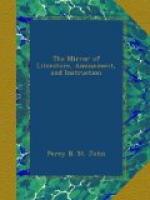THE LAY OF THE LAST MINSTREL.
Sir Walter’s secession from the law was followed by the production of his noblest poem—the Lay of the Last Minstrel—the origin of which is thus related by the author:
“The lovely young Countess of Dalkeith, afterwards Harriet, Duchess of Buccleuch, had come to the land of her husband, with the desire of making herself acquainted with its traditions and customs. Of course, where all made it a pride and pleasure to gratify her wishes, she soon heard enough of Border lore; among others, an aged gentleman of property, near Langholm, communicated to her ladyship the story of Gilpin Horner—a tradition in which the narrator and many more of that county were firm believers. The young Countess, much delighted with the legend, and the gravity and full confidence with which it was told, enjoined it on me as a task to compose a ballad on the subject. Of course, to hear was to obey; and thus the goblin story, objected to by several critics as an excrescence upon the poem, was, in fact, the occasion of its being written.”
Sir Walter having composed the first two or three stanzas of the poem—taking for his model the Christabel of Coleridge—showed them to two friends, “whose talents might have raised them to the highest station in literature, had they not preferred exerting them in their own profession of the law, in which they attained equal preferment.” They were more silent upon the merits of the stanzas than was encouraging to the author; and Sir Walter, looking upon the attempt as a failure, threw the manuscript into the fire, and thought as little as he could of the matter. Sometime afterwards, Sir Walter meeting his two friends, was asked how he proceeded in his romance;—they were surprised at its fate, said they had reviewed




